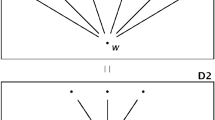Abstract
In this paper, I present the thesis of Composition as Identity (CAI) as I think it should be understood (Sects. 1, 2), and reply to some objections to it (Sects. 3, 4). My aim is not to argue that CAI is true, but to show how CAI can be true, and push the debate forward in the direction I think it must and should go in light of some new objections.
Similar content being viewed by others
Notes
Whenever I say that plural variables range over pluralities of objects, I take them to range over one or more objects, not plural objects (whatever that means). A plurality of objects is just those objects. In other words, singular quantification and plural quantification are just two different ways of quantifying over the same objects. It is not committed to quantifying over different domains, or different kinds of objects. Cf. Boolos (1984).
One might, on the one hand, reject HII as ungrammatical and incoherent, or one might, on the other hand, accept HII as grammatical and coherent, but hold that it only has vacuously true instance where the antecedent is false (except when the value of ‘xx’ is singular). A CAI-fan like myself thinks it is both coherent and has non-vacuously true instances.
Deriving classical mereology from GI and CAI is tedious, and not something I can do here. But note that we can and should add a syntactic restriction so that the composition predicate C doesn’t behave symmetrically, like identity does. For example, ‘xCyy’ should not come out well-formed, even though ‘x = yy’ and ‘xCx’ do (and are true). I want to derive classical mereology from GI and CAI, not revise classical mereology.
I take it to be pretty obvious that it is not a lexical definition.
Where f(xx) is the unique fusion of xx. Proof: Right-to-Left: assume y is part of ƒ(xx). The fusion ƒ(xx) is composed of xx as well as y,ƒ(xx); so given CAI, ƒ(xx) = xx and ƒ(xx) = y,ƒ(xx); and hence, by HII, xx = y,ƒ(xx). But y is one of y,ƒ(xx); hence, by HII, y is one of xx. Left-to-Right: assume y is one of xx. It is obvious that z = ƒ(xx) iff each one of xx is a part of z and each part of z overlaps at least one of xx (this is usually part of the definition of fusion). But if each one of xx is a part of z, then since y is one of xx, y is a part of z; hence, y is a part of ƒ(xx). Q.E.D.
I treat’mode of presentation’ and’concept’ interchangeably.
A set of a,b,c has only one ultimate decomposition, namely into its members a, b and c; a composite fusion of a,b,c on the other hand might have a further ultimate decomposition into parts of a, b and c. The properties involved in the objections above are more like sets than fusions in this respect; hence the characterization set-like.
For what it is worth, the relativity I suggest is not Frege’s view. While I hold cardinal properties to be relative to concepts, Frege holds cardinal properties to be properties of concepts.
Note that CAI is, by Necessitation, a thesis that holds of necessity, so the mere possibility of emergent properties is enough to get the problem. The same goes for the other problematic properties we’ll discuss below.
These problems are greatly inspired by a talk Philip Bricker gave at the conference Mereology and Identity in Pisa, Italy, July 2017. But, of course, all confusions are mine.
Note that I am here talking about plural and mereological metaphysical structure in fundamental reality, not merely structures as a matter of linguistics or semantics.
The bubbling up principle (but without the mentioning of the distributivity or directionality) has come up at least once during Q&A in various talks I have given on the trickling down principle over the last couple of years, but I cannot now remember where and when it first came up.
Thanks to the audience at the conference Mereology and Identity in Pisa, Italy, July 2017, and the anonymous referees for this journal.
References
Armstrong, D. (1978). A theory of universals. Volume 1 & 2. Cambridge: Cambridge University Press.
Armstrong, D. (1997). A World of States of Affairs. Cambridge: Cambridge University Press.
Baxter, D. (1988a). Identity in the loose and popular sense. Mind, 97(388), 575–582.
Baxter, D. (1988b). Many-one identity. Philosophical Papers, 17(3), 193–216.
Bohn, E. D. (2009a). An argument against the necessity of unrestricted composition. Analysis, 69(1), 25–29.
Bohn, E. D. (2009b). Must there be a top level? Philosophical Quarterly, 59(235), 193–201.
Bohn, E.D. (2009c). Composition as identity. Doctoral Dissertation. University of Massachusetts Amherst.
Bohn, E. D. (2011). Commentary on ‘parts of classes’. Humana. Mente, 19, 151–158.
Bohn, E. D. (2012). Monism, emergence and plural logic. Erkenntnis, 76(2), 211–223.
Bohn, E. D. (2014a). Unrestricted composition as identity. In D. Baxter & A. Cotnoir (Eds.), 2014. Composition as Identity: Oxford University Press.
Bohn, E. D. (2014b). From Hume’s Dictum via submergence to composition as identity or mereological Nihilism. Pacific Philosophical Quarterly, 95(3), 336–355.
Bohn, E. D. (2016). Composition as identity and Plural Cantor’s theorem. Logic and Logical Philosophy, 25(3), 411–428.
Bohn, E. D. (2018). Normativity all the way down: From normative realism to pannormism. Synthese, 195(9), 4107–4124.
Bohn, E. D. (forthcoming). Panpsychism, the combination problem, and plural collective properties. Australasian Journal of Philosophy. Early view at https://doi.org/10.1080/00048402.2018.1483410.
Boolos, G. (1984). To be is to be the value of a variable (or some values of some variables). In Boolos, G. (1998). Logic, logic, and logic. Harvard University Press.
Bricker, P. (2016). Composition as a kind of identity. Inquiry, 59(3), 264–294.
Cameron, R. (2012a). Composition as identity doesn’t settle the special composition question. Philosophy and Phenomenological Research, LXXXIV(13), 531–554.
Cameron, R. (2012). (2007). The contingency of composition. Philosophical Studies 136/1, pp. 99–121.
Cotnoir, A. (2013). Composition as general identity. Oxford studies in metaphysics, Vol. 8, Oxford University Press.
Frege, G. (1884). The Foundations of Arithmetic. As translated by J.L.Austin. Blackwell, 1980
Hawley, K. (2013). Cut the pie anyway you like? Cotnoir on general identity. Oxford Studies in Metaphysics, Vol. 8, Oxford University Press.
Lewis, D. (1983). New work for a theory of universals. Australasian Journal of Philosophy, 61(4), 343–377.
Lewis, D. (1991). Parts of classes. Oxford: Blackwell.
McDaniel, K. (2008). Against composition as identity. Analysis, 68(2), 128–133.
McDaniel, K. (2010). Composition as identity does not entail universalism. Erkenntnis, 73(1), 97–100.
Merricks, T. (2003). Objects and persons. Oxford: Oxford University Press.
Parsons, J. (2004). Distributional properties. In F. Jackson & G. Priest (Eds.), Lewisian Themes: The philosophy of David K. Lewis. Oxford: Oxford University Press.
Schaffer, J. (2010). Monism: the priority of the whole. Philosophical Review, 119(1), 31–76.
Sider, T. (2007). Parthood. Philosophical Review, 116, 51–91.
Sider, T. (2014). Consequences of collapse. In D. Baxter & A. Cotnoir (Eds.), Composition as identity. Oxford: Oxford University Press.
Van Inwagen, P. (1994). Composition as identity. In P. van Inwagen (Ed.), Ontology, identity and modality. Cambridge: Cambridge University Press.
Wallace, M. (2009). Composition as identity. Doctoral Dissertation. University of North Carolina, Chapel Hill.
Wallace, M. (2011). Composition as identity. Part 1 & 2. Compass, 6(11), 804–827.
Yi, B.-U. (1999). Is mereology ontologically innocent? Philosophical Studies, 93(2), 141–160.
Author information
Authors and Affiliations
Corresponding author
Additional information
Publisher’s Note
Springer Nature remains neutral with regard to jurisdictional claims in published maps and institutional affiliations
Rights and permissions
About this article
Cite this article
Bohn, E.D. Composition as identity: pushing forward. Synthese 198 (Suppl 18), 4595–4607 (2021). https://doi.org/10.1007/s11229-019-02193-x
Received:
Accepted:
Published:
Issue Date:
DOI: https://doi.org/10.1007/s11229-019-02193-x




